Dorina BOSITS: The Road Towards the Era of Digitalization: The Evolution of European Regulation on Freedom of Expression
The purpose of this essay is to provide a holistic view on some of the milestones of the evolution of the international regulation on the freedom of expression in Europe, introducing the Universal Declaration of Human Rights, the Charter of Fundamental Rights of the European Union, the Digital Services Act and touches upon the AI Act of the European Union.
The starting point of freedom rights in Europe is considered to be the French Revolution’s “Declaration of the Rights of Man and of the Citizen” from 1789. However, this document has presented solely a preliminary content compared to the modern fundamental human rights after the Second World War[1]. After the war, demand for peace intensified and basic principles arose which could not only contribute to the self-determination of a person but also represent the interests of the public on a wider scale[2].
Only three years after the end of the war, the Universal Declaration of Human Rights (UDHR) of the United Nations’ General Assembly in 1948 in Paris was proclaimed, which is seen as a revolutionary document and a milestone in history. Since then, several documents have been accepted, and almost all documents handle the UDHR as a sample document, a source of inspiration for the further development of human rights[3]. Article 19 of the UDHR declares the freedom of opinion and expression which right is defined as “the freedom to hold opinions without interference and to seek, receive and impart information and ideas through any media and regardless of frontiers.”[4] As shown, it expands the right to not only the expression of one’s opinion but also the access to information, as it shall be available and accessible through any kind of media[5]. In the Preamble, freedom of speech is highlighted: one shall be allowed to express his or her opinion through speech without having to fear being negatively discriminated against after expressing that opinion.
Although this right could appear to be unrestricted, the second section of Article 29 of the UDHR states that freedom can and shall be limited – but only for the protection of the rights of others, and these constraints shall be proportionate[6]. As mentioned above, this international proclamation only outlined the fundamental principles of human rights and provided merely broad definitions. However, the aspirational, generalist view[7] of the document has led to the need for new, more detailed, and more precisely formulated acts in the modern age, where technological advancements changed the landscape of legislation.
With the positive development of European cooperation in the second half of the twentieth century, in 1950, the European Convention on Human Rights (ECHR) was proclaimed, and up until today, 47 European countries have signed this agreement, from which 27 countries are also EU member states[8]. The ECHR in Article 10 highlights freedom of expression as a key fundamental right to protect and emphasizes that this protection does not only refer to “true” statements[9]. The ECHR serves as one of the first commitments of European countries to the UDHR, and today, when a country wishes to join the European Union, it is one of the many criteria that it needs to sign and ratify the ECHR[10].
By the last quarter of the twentieth century, the European Union (EU) was established as a sui generis institution[11]. After the treaty in Maastricht in 1992 and a small adjustment in the Treaty of Amsterdam in 1999 were proclaimed, the question of a European fundamental rights agreement arose between the states[12]. Later, this agreement became the Charter of Fundamental Rights of the European Union and the purpose of this Charter was to protect the citizens of the European Union and to clarify the rights historically established between individual Member States[13]. The Charter of the European Union was signed in 2000[14], and a consolidated version entered into force together with the Lisbon Treaty in 2012[15]. The Charter incorporated several principles from the UN’s Universal Declaration of Human Rights and expanded regulation and definitions in several articles.
Article 11 incorporates the same content as the UDHR; however, the article added a second section highlighting the freedom and diversity of the media. Limitations, as in the case of UDHR, are not listed in this article but only mentioned later in Article 52 about the interpretation and scope of these rights. This article is broken down into several sections and is placed in the provisional part where the way of application of the charter is detailed. Compared to the first version of the Charter from 2000, the applications are more detailed in the 2012 version. Section 1 of Article 52 emphasizes that the essence of the rights shall be respected and applied with respect to proportionality. Any limitation to rights such as the freedom of expression can only be introduced when it is necessary and only in the interest of the public good while not contradicting other principles and rights. Article 21 further highlights the avoidance of discrimination in the case of any personal belief, political opinion, and other views. At the end of the document, in Article 54, the prohibition of abuse of these principles and rights is stated. No right or activity is allowed to be used for the destruction of any other right or principle[16].
The European Court of Human Rights (ECtHR) has developed a 6-step stress-test that states different discretionary criteria according to which a limiting decision can be made. The test provides international companies with step-by-step guidance to monitor content on their platforms, so they can ensure alignment with the international regulation on fundamental rights, especially with freedom of expression. According to this, companies shall be observed from different angles case by case to form a decision whether the content can be limited or not[17]. The ECtHR was established by the ECHR in 1950 in Strasbourg and works as an independent international court.[18] This 6-step-stress-test serves as a guideline next to the Charter but is independent from the document itself. However, since all EU Member States must sign and ratify the ECHR, they accept the jurisdiction of the ECtHR as well as the consolidated version of the Charter of Fundamental Rights in the Lisbon Treaty[19].
In the past years, the need for new digital regulations arose within the EU. After two years of work, in 2022, the Digital Services Act (DSA)[20] was introduced together with the Digital Markets Act (DMA)[21] that regulates the online markets’ competition. These two acts intend to regulate the online space extensively and tries to harmonize the users’ rights and obligations within the EU[22]. The need for comprehensive legislation is proven by the online space’s lack of security and protection. However, the content of the new regulation shows that the previous EU documents dealing with fundamental rights still serve as a dogmatic background for the new acts. Therefore, the DSA and the DMA shall be regarded as more detailed and specified acts which are complementary to the previously stated, more dogmatic documents and not as replacements.
Besides unification of regulation on the digital space in Europe, one of the fundamental purposes of the DSA is to strengthen freedom of expression. Most international regulations put emphasis on the limitations in alignment with the fundamental rights. The DSA, however, strives to protect freedom of expression and the possibility to spread one’s opinion freely[23]. The DSA requires large search engines and online platforms to make their algorithmic methods understandable for the users, however, Decarolis and Li warns that regulators should remember that such online platforms can easily adapt to the new environment and come up with new ways to outmaneuver the applicable rules[24]. The document clearly refers to the Charter in its preamble and restates the most important fundamental principles and rights highlighting the importance of freedom of expression as well[25]. The Preamble mentions in 14 different sections freedom of expression which indicates that it is a general guiding principle for the document. In other four instances, the main articles discuss the obligations of online platforms to ensure freedom of expression[26].
As online platforms are getting too big to be allowed to self-regulate, as they can mean a potential threat to democracy, the DSA initiative introduced a balanced system, where the first layer to turn to is the company’s self-regulations which serve as buffers against abusive governmental control and strive for better enforceability within the organization. The DSA, as a secondary layer, prescribes monitoring mechanisms and measures that try to protect users to express their opinions freely. However, it states that a self-regulatory environment to some extent is necessary to prevent potential government overreach[27]. The real breakthrough of the DSA can be found in its fine system, where the penalty payments became maximized in case of failure to comply with the regulation. According to Article 52, the imposable fines can take up to 6% of the annual worldwide turnover of the intermediary in case of not fulfilling its obligations[28]. The Digital Services Act provides Member States and international online platforms with an extensive set of regulations that they must obey but enforceability in case of global media giants and the clear borders of freedom of expression remain blurry and are not completely drawn up.
Freedom of expression and its potential limitations have been debated since ancient times, but after the end of the second World War, the conversation has been revived and regulation such as the UDHR and the Charter started to determine the main principles of freedom of expression. In the 21st century, the need for a separated regulation for digital platforms increased and with that, the DSA and the DMA were created. Another challenge, one has to face in the modern world is the increased usage of Artificial Intelligence (AI). Thus, the need for regulation arose in that area as well, which also influence the limits of freedom of expression. With the upcoming negotiation on an AI Act, regulation on fundamental human rights is about to become more detailed and specialized in the digital space.
[1] Lassányi Tamás: A véleménynyilvánítás szabadsága az Interneten. In. Az információs társadalom felé. Tanulmányok és hozzászólások. In. Replika Kör, 2001. Budapest, p.130.
[2] Lassányi Tamás: A véleménynyilvánítás szabadsága az Interneten. In. Az információs társadalom felé. Tanulmányok és hozzászólások. In. Replika Kör, 2001. Budapest, p.132.
[3] United Nations: Universal Declaration of Human Rights. 1948. https://www.un.org/en/about-us/universal-declaration-of-human-rights Accessed on 11 July 2023.
[4] United Nations: Universal Declaration of Human Rights. – Article 19. 1948. https://www.un.org/en/about-us/universal-declaration-of-human-rights Accessed on 18 July 2023.
[5] United Nations: Universal Declaration of Human Rights. – Article 19. 1948. https://www.un.org/en/about-us/universal-declaration-of-human-rights Accessed on 11 July 2023.
[6] United Nations: Universal Declaration of Human Rights – Article 29 Section 2. 1948. https://www.un.org/en/about-us/universal-declaration-of-human-rights Accessed on 11 July 2023.
[7] Özler, Ş. İlgü: The Universal Declaration of Human Rights at Seventy: Progress and Challenges. In Ethics & International Affairs. Winter 2018 (32.4). https://www.ethicsandinternationalaffairs.org/journal/the-universal-declaration-of-human-rights-at-seventy-progress-and-challenges#:~:text=The%20first%20and%20most%20basic,framework%20for%20actually%20achieving%20them. Accessed on 18 July 2023.
[8] European Union: European Convention on Human Rights. https://eur-lex.europa.eu/EN/legal-content/glossary/european-convention-on-human-rights-echr.html#:~:text=Signed%20in%201950%20by%20the,are%20members%20of%20the%20EU. Accessed on 19 July 2023.
[9] Council of Europe: The European Convention on Human Rights – Article 10. https://www.coe.int/en/web/human-rights-convention/expression Accessed on 19 July 2023.
[10] Council of Europe: The European Convention on Human Rights – The Convention in 1950. https://www.coe.int/en/web/human-rights-convention/the-convention-in-1950 Accessed on 19 July 2023.
[11] Milana, Marcella: European Union. 2023. In. International Encyclopedia of Education (Fourth Edition). Published on 18 November 2022., p.494. https://doi.org/10.1016/B978-0-12-818630-5.01057-5
[12] Hobe, Stephan: Will the European constitution lead to a European super-state? In. Futures. Vol. 38. No. 2. Published in March 2006. p.171-172. https://doi.org/10.1016/j.futures.2005.04.014
[13] Equality and Human Rights Commission: What is the Charter of Fundamental Rights of the European Union? Updated on 2 August 2021. https://www.equalityhumanrights.com/en/what-are-human-rights/how-are-your-rights-protected/what-charter-fundamental-rights-european-union Accessed on 12 July 2023
[14] European Parliament: Charter of Fundamental Rights of the European Union. 2000. In. Official Journal of the European Communities. https://www.europarl.europa.eu/charter/pdf/text_en.pdf Accessed on 12 July 2023.
[15] European Parliament: Consolidated Version of the Treaty on the Functioning of the European Union. 2012. In. Official Journal of the European Communities.
[16] European Parliament: Consolidated Version of the Treaty on the Functioning of the European Union. 2012. In. Official Journal of the European Communities.
[17] Gosztonyi, Gergely: Some human and technical aspects of online content regulation. In. Journal of Liberty and International Affairs, Bitola, Institute for Research and European Studies, 2021, Vol.7. No. 3. p.159. https://www.ajk.elte.hu/dstore/document/3077/ELTE_AJK_Annales_2019%2007%20Gosztonyi.pdf
[17] European Commission: The Digital Services Act: ensuring a safe and accountable online environment. 2022. https://commission.europa.eu/strategy-and-policy/priorities-2019-2024/europe-fit-digital-age/digital-services-act-ensuring-safe-and-accountable-online-environment_en Accessed on 14 July 2023.
[18] European Court of Human Rights: Questions and Answers. n.d. P.3. https://www.echr.coe.int/documents/d/echr/Questions_Answers_ENG Accessed on 19 July 2023.
[19] European Union: European Convention on Human Rights. https://eur-lex.europa.eu/EN/legal-content/glossary/european-convention-on-human-rights-echr.html#:~:text=Signed%20in%201950%20by%20the,are%20members%20of%20the%20EU. Accessed on 19 July 2023.
[20] European Union: Regulation (EU) 2022/2065 of the European Parliament and of the Council on a Single Market for Digital Services and amending Directive 2000/31/EC (Digital Services Act). 2022.
[21] European Union: Regulation (EU) 2022/1925 of the European Parliament and of the Council on contestable and fair markets in the digital sector and amending Directives (EU) 2019/1397 and (EU) 2020/1828 (Digital Markets Act). 2022.
[22] European Commission: The Digital Services Act: ensuring a safe and accountable online environment. 2022. In. European Commission. https://commission.europa.eu/strategy-and-policy/priorities-2019-2024/europe-fit-digital-age/digital-services-act-ensuring-safe-and-accountable-online-environment_en Accessed on 16 July 2023.
[23] European Publishers Council: The Digital Services Act must safeguard freedom of expression online. 2022. https://www.epceurope.eu/post/the-digital-services-act-must-safeguard-freedom-of-expression-online#:~:text=3%20min-,The%20Digital%20Services%20Act%20must%20safeguard%20freedom%20of%20expression%20online,between%20citizens%20online%20is%20curtailed. Accessed on 15 July 2023.
[24] Decarolis, Francesco, and Muxin Li: Regulating Online Search in the EU: From the Android Case to the Digital Markets Act and Digital Services Act. 2023.p.2-3. https://doi.org/10.1016/j.ijindorg.2023.102983
[25] European Union: Regulation (EU) 2022/2065 of the European Parliament and of the Council on a Single Market for Digital Services and amending Directive 2000/31/EC (Digital Services Act) – Preamble (3). 2022.
[26] European Union: Regulation (EU) 2022/2065 of the European Parliament and of the Council on a Single Market for Digital Services and amending Directive 2000/31/EC (Digital Services Act) – Article 14, Article 34, Article 47, Article 91. 2022.
[27] Gamito Cantero, Marta: The European Media Freedom Act (EMFA) as Meta-Regulation. 2023. In. Computer Law & Security Review. p.19. https://doi.org/10.1016/j.clsr.2023.105799
[28] European Union: Regulation (EU) 2022/2065 of the European Parliament and of the Council on a Single Market for Digital Services and amending Directive 2000/31/EC (Digital Services Act) – Article 52. 2022.
Dorina BOSITS is a law student at the Széchenyi István University of Győr, Hungary, and an international finance and accounting graduate of the University of Applied Sciences of Wiener Neustadt, Austria. The main area of her research includes freedom of speech, digitalization, data protection, and financial law. She is a student at the Law School of MCC and a member of ELSA Győr.








